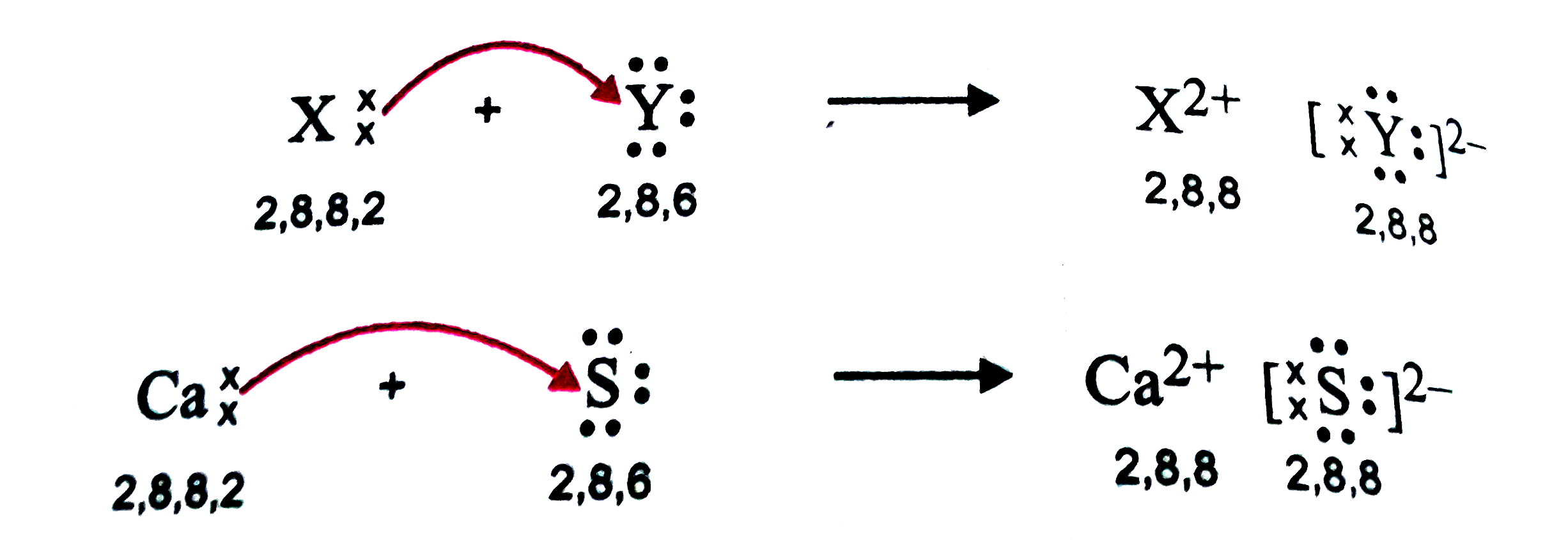An element X has same number of electrons in the first and the fourth shell as well as in the second and the third shell.
(a) Write down the electronic configuration of the element.
( b) Write down the group number and the period to which it belongs
( c) What is the valency of the element ?
(d ) Will it form ionic or covalent compound with the element Y (2,8,6) ?
( e) What is the nature of the oxides of X and Y ?
(a) We know that the maximum number of electrons in the Ist and 2nd shell are 2 and 8 respectively .Since 3rd shell has the same number of electrons as the 2nd shell therefore 3rd shell also has 8 electrons.
Further since 4th shell has the same number of electrons as the 1st shell therefore 4th shell has two electrons. Therefore the electronic configuration of the element X is 2,8,8,2 Actually the element X is Ca.
(b) Since in the element X the valence electrons are present in the fourth shell , therefore the period of element X is 4 .Further since is has two electrons in the valence shell therefore its group number is 2.
( c) Valencey of the element X ( 2,8,8,2) i.e., Ca has two electrons more and the element Y (2,8,6 ) i.e., S has two electrons less than the stable electronic configuration of the nearest gas argon (2,8,8) therefore X transfers two electrons to Y to form ionic compound.

(e ) Since X is a metal therefore its oxide is basic i.e., CaO. Since Y is a non- metal therefore its oxide is acidic i.e., SO2 or SO3
Topper's Solved these Questions
- BOOK - PRADEEPCHAPTER - CLASSIFICATION OF ELEMENTS AND PERIODICITY IN PROPERTIES EXERCISE - Test Your Grip Multiple choice questions I15videos
CLASSIFICATION OF ELEMENTS AND PERIODICITY IN PROPERTIES
- BOOK - PRADEEPCHAPTER - CLASSIFICATION OF ELEMENTS AND PERIODICITY IN PROPERTIES EXERCISE - Test Your Grip (Fill in the Blanks) II15videos
CLASSIFICATION OF ELEMENTS AND PERIODICITY IN PROPERTIES
- BOOK - PRADEEPCHAPTER - CLASSIFICATION OF ELEMENTS AND PERIODICITY IN PROPERTIES EXERCISE - Problems For Practice27videos
CLASSIFICATION OF ELEMENTS AND PERIODICITY IN PROPERTIES
- BOOK - PRADEEPCHAPTER - CHEMICAL BONDING AND MOLECULAR STRUCTUREEXERCISE - Curiosity Questions2videos
CHEMICAL BONDING AND MOLECULAR STRUCTURE
- BOOK - PRADEEPCHAPTER - ENVIRONMENTAL CHEMISTRYEXERCISE - COMPETITION FOCUS (JEE(Main and Advanced)/Medical Entrance (VI.ASSERTION-REASON) Type II6videos
ENVIRONMENTAL CHEMISTRY
Similar Questions
Knowledge Check
- Question 1 - Select One
The electronic configuration of the element which is just above the element with atomic number 43 in the same periodic group is
A1s22s22p63s23p63d54s2B1s22s22p63s23p63d104s24p5C1s22s22p63s23p63d64s1D1s22s22p63s23p63d104s14p6
Write the electronic configuration of the first four elements in this group.
View SolutionWrite the electronic configuration of the first four elements in this group.
View SolutionWrite the electronic configuration of an element X whose atomic number is 12.
View SolutionWrite down the electronic configuration of an element with atomic number 14. Which group in the periodic table does this element belong to ?
View SolutionWrite the electronic configuration of the element with atomic number 17. Indicate the valency of the element.
View SolutionWrite the electronic configuration of the element present in the third period and seventeenth group of the periodic table.
View SolutionWhat is the valence shell electronic configuration of group 13 elements?
View Solution

